
Rev0411
Service and Support: 866-869-3114
Models:
Pt# 1312100743
Air Compressor
Manual

TABLE OF CONTENTS
PAGE
1 Safety Guidelines - Definitions
Before Using the Air Compressor
2 When Installing or Moving the Compressor
Before Each Use
3 Follow Safety Precautions for Electrical Connection
Plan Ahead to Protect Your Eyes, Hands, Face & Ears
When Operating
4 Spraying Precautions
Perform These Maintenance Operations
5 Typical Compressor Installation
Glossary
6 Wiring
7 Starting the Compressor
8 Fully Packaged and QP Compressor Section
9 Troubleshooting Guide
10 Troubleshooting (Cont.)
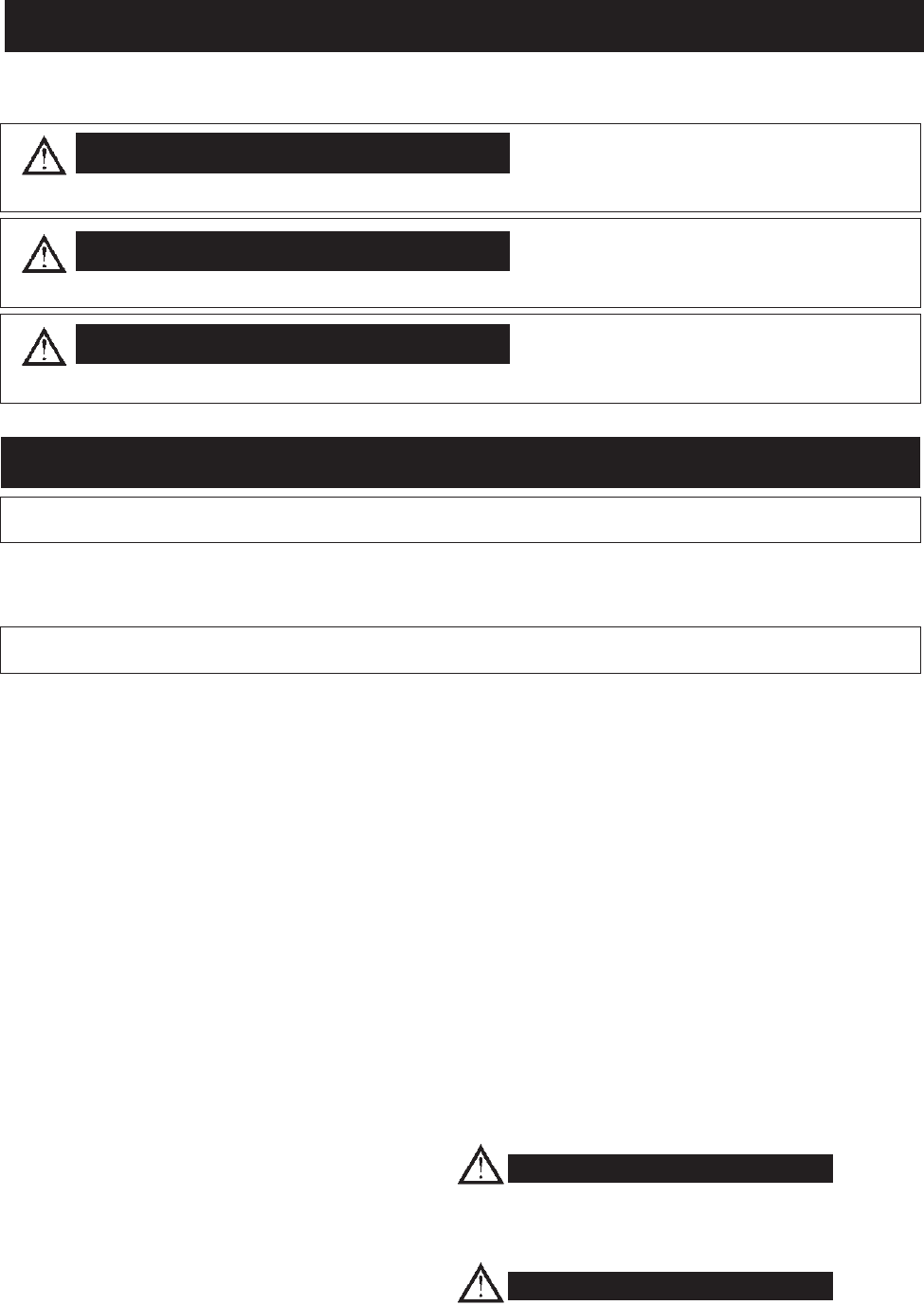
WARNING
Safety is a combination of common sense, staying alert and knowing how your compressor works.
Read this manual to understand this compressor.
CAUTION
DANGER
SAFETY GUIDELINES - DEFINITIONS
means if safety information is not followed someone will be seriously injured or killed
means if safety information is not followed someone may be seriously injured or killed
means if safety information is not followed someone could be seriously injured or killed
IMPORTANT SAFETY INSTRUCTIONS
Save these instructions
Before using the air compressor
Improper operation or maintenance of this product could result in serious injury and property
damage. Read and understand all warnings and operation instructions before using this compressor.
Air compressors are utilized in a variety of air
system applications. Because air compressors
and other components (hoses, connectors, air
tools, spray guns, etc.) make up a high pressure
pumping system, the following safety pre-
cautions should be observed at all times.
Only persons familiar with these rules of
safe operation should use the air
compressor.
1. Read the instruction manual carefully before
attempting to assemble, disassemble or
operate your system. Be thoroughly familiar
with the controls and the proper use of the
equipment.
2. Review and understand all safety instructions
and operating procedures in this manual.
3. Review the maintenance methods for this
compressor (See “Maintaining Your
Compressor” section).
Things you should know Inspect your work area
1. Keep work area clean.
2. Cluttered areas and benches invite accidents.
Floors must not be slippery from wax or dust.
1. To reduce the risk of injury from accidental
starting, turn switch off and disconnect the
power before checking it.
2. If any part is missing, bent or broken in any
way, or any electrical part does not work prop-
erly, keep the compressor off and disconnected.
3. Check hoses for weak or worn condition
before each use, making certain all connections
are secure. Do Not use if defect is found.
Do not operate compressor if damaged during
shipping, handling or use. Damage may result
in bursting and cause injury or property damage.
This compressor is Not designed for and should
not be used in breathing air applications.
Inspect your compressor
WARNING
Page 1
DANGER
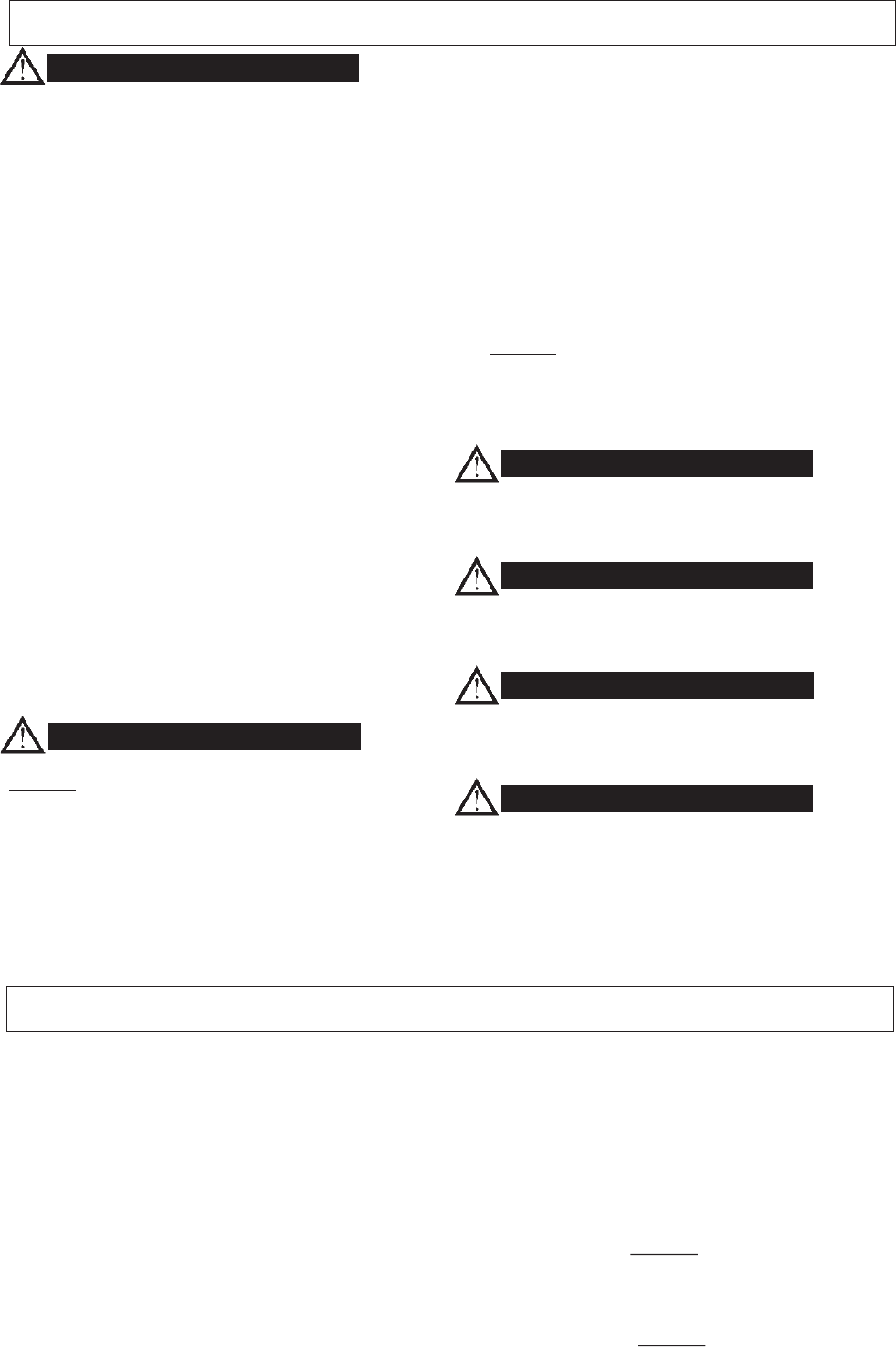
When installing or moving the compressor
This compressor is extremely top heavy. The
compressor must be secured to the floor
before operating to prevent equipment
damage, injury or death. The compressor must
be mounted on vibration pads. Do Not tighten
bolts completely as this may cause stress to
the tank welds.
To reduce the risk of a dangerous
environment
1. Keep work area well lit.
2. Operate compressor in a well-ventilated
area free from flammable liquids and vapors.
3. Operate compressor in a ventilated area so
that compressor may be properly cooled and
the surrounding air temperature will not be
more than 100°F.
4. Never use a compressor in a wet
environment.
5. Protect material lines and air lines from
damage or puncture. Keep hose and
wires away from sharp objects, chemical
spills, oil, solvents and wet floors.
Do Not secure compressor with toggle bolts
into drywall. Drywall sheeting or plaster will not
support the weight of the compressor.
WARNING
Page 2
6. A minimum clearance of 18 inches between
the compressor and a wall is required
because objects could obstruct airflow.
7. The compressor should be located where it can
be directly wired to a circuit breaker. The
compressor should be wired by a qualified
electrician.
8. Never store flammable liquids or gases in
the vicinity of an operating compressor.
9. Do Not locate the compressor air inlet near
steam, paint spray, sandblasting areas or
any other source of contamination. The
debris could damage the motor and pump.
Never use plastic (PVC) pipe for compressed
air. Serious injury or death could result.
Never use the shipping skid for mounting the
compressor.
This compressor is not intended for outdoor
installation.
Never install a shut off valve between the compres-
sor pump and tank. Personal injury and/or
equipment damage could occur.
WARNING
CAUTION
NOTICE
WARNING
WARNING
Before each use
1. Keep work area clean. Cluttered areas and
benches invite accidents.
2. The floor must not be slippery from wax or
dust.
1. To reduce the risk of injury from accidental
starting, turn the switch off and disconnect
power.
2. If any part is missing, bent or broken in any
way, or any electrical part does not work
properly, keep the compressor off and dis-
connect power. Do Not use if defect is found.
3. Check hoses for weak or worn condition
before each use, making certain all connect-
ions are secure. Do Not use if a defect is
found.
Inspect your work area Inspect your compressor
Note: Tank Outlet Size: 30 Gallon Gas Drive - 1/2” NPT
80 and 120 Gallon Electric - 3/4” NPT
Duplex - 1” NPT

Follow the safety precautions for electrical connections
Page 3
WARNING
CAUTION
WARNING
Plan ahead to protect your eyes, hands, face and ears
1. Wear safety glasses (meeting ANSI Z87.1 or
in Canada CSA Z94.3-99) and use hearing
protection when operating the unit. Everyday
glasses are not safety glasses.
2. Wear shoes to prevent shock hazards.
3. Tie back long hair.
Keep fingers away from running compressor.
Fast moving and hot parts may cause injury
and/or burns.
1. Follow all local electrical and safety codes,
as well as the National Electric Code (NEC)
and the Occupational Safety and Health
Act (OSHA).
2. Wiring and fuses should follow electrical
codes, current capacity and be properly
grounded.
3. Protect wires from contact with sharp objects.
All electrical connections should be made by
a qualified electrician.
Dress for safety
Be careful when touching the exterior of comp-
ressor, pump, motor and air lines; they may
become hot enough to cause injury.
Never operate the compressor without a
beltguard. The compressor can start auto-
matically without warning. Personal injury or
property damage could occur from contact
with moving parts.
The compressor may be hot even if the unit is
stopped.
Use of a mask or respirator per chemical
manufacturers’ instructions may be neces-
sary if there is a chance of inhaling toxic fumes.
Read mask and respirator instructions care-
fully. Consult a safety expert if you are not
sure about the use of certain masks or
respirators.
Pay attention to your hands
WARNING
CAUTION
WARNING
When operating
1. Do not exceed the pressure rating of any
component of the system.
2. Release pressure within the system slowly
to prevent flying dust and debris.
3. If the equipment starts to abnormally vibrate,
STOP the compressor immediately and
check for the cause.
WARNING
Never change the safety valve or pressure
switch settings. Keep safety valve free from
paint and other accumulations. See compressor
specification decal for maximum operating
pressure. Do not operate with the pressure
switch set higher than the maximum operating
pressure.
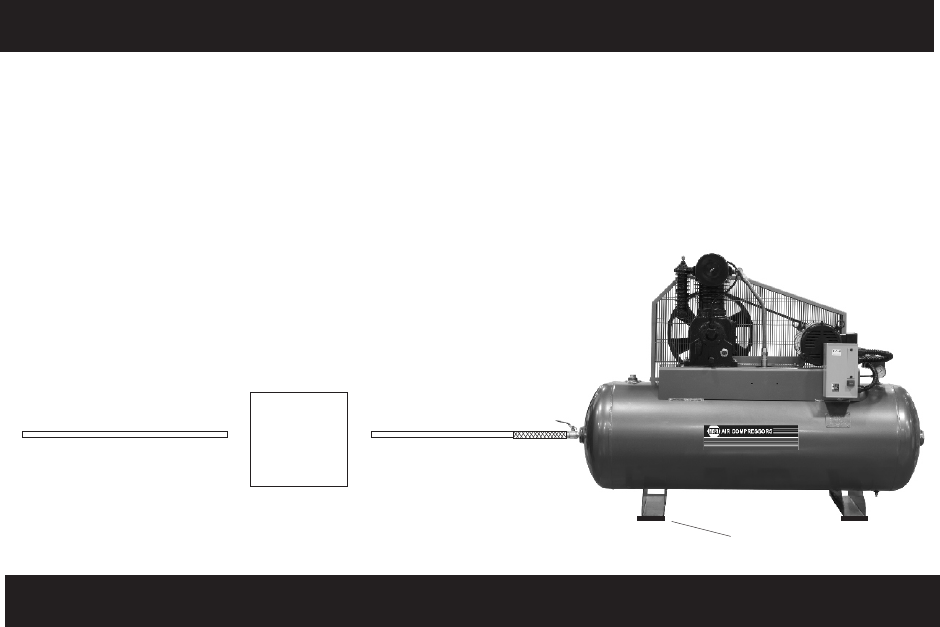
Page 5
WIRING
TYPICAL COMPRESSOR INSTALLATION
GLOSSARY OF TERMS
Air Filter
Porous element contained within a metal or
plastic housing attached to the compressor
cylinder head which removes impurity from the
intake air of the compressor.
Air Tank
Cylindrical component which contains the
compressed air.
Check Valve
Device which prevents compressed air from
flowing back from the air tank to the compres-
sor pump.
Electric Motor
Device which provides the rotational force
necessary to operate the compressor pump.
Pressure Gauge
Device which shows the tank or regulated
pressure of the compressed air.
Pressure Switch
Device which automatically controls the on/off
cycling of the compressor. It stops the
compressor when the cut-off pressure in
the tank is reached and starts the compressor
when the air pressure drops below the cut-in
pressure.
PSI (Pounds per Square Inch)
Measurement of the pressure exerted by the
force of air. The actual psi is measured by a
pressure gauge on the compressor.
Pump
Device which produces the compressed air
with a reciprocating piston contained within a
cylinder.
Safety Valve
Device which prevents air pressure in the air
tank from rising over a predetermined limit.
Thermal Overload Switch
Device, integrated into the electric motor winding,
which automatically “shuts off” the compressor
if the temperature of the electric motor exceeds
a predetermined limit.
Flex
Hose
Air
Dryer
To Air System
Vibration Pads

Spraying precautions
Page 4
Perform these maintenance operations
1. Do Not spray in the vicinity of open flames
or other places where a spark can cause
ignition. Do Not smoke when spraying
paint, insecticides, or other flammable
substances.
1. When spraying with solvents or toxic chemi-
cals, follow the instructions provided by the
chemical manufacturer. Consult a safety
expert if unsure about the use of masks or
respirators.
2. If the material you intend to spray contains
trichloreoethane and methylene chloride, do
not use accessories that contain aluminum or
galvanized materials, as these chemicals can
react with galvanized components causing
corrosion and weakening equipment. Use
stainless steel accessories.
WARNING
Never point a spray gun at yourself or any
other person or animal. Accidental discharge
may result in serious injury.
Reduce the risk of dangerous
environment
WARNING
Extreme caution should be taken when
spraying flammable liquids as the spark from
a motor or pressure switch may cause a fire
or explosion. Ample ventilation must be
provided.
WARNING
Spray in a well ventilated area to keep fumes
from collecting and causing serious injury and
fire hazards.
Be informed about the materials you use
1. Do regular maintenance; keep all nuts, bolts,
and screws tight, to be sure equipment is in
safe working condition.
2. Inspect tank yearly for rust, pin holes or any
other imperfections that could cause it to
become unsafe.
NEVER attempt to repair or modify a tank!
Welding, drilling or any other modification will
weaken the tank resulting in damage from
rupture or explosion. Always replace worn,
cracked or damaged tanks.
3. Clean electrical equipment with an approved
cleaning agent, such as a dry, non-flam-
mable cleaning solvent.
Daily
Check oil level at sight glass. Oil level should
be 1/2 to slightly higher in the oil sight glass.
Drain moisture from tank.
Verify the pressure switch unloader is
working by listening for a brief hissing sound
when the compressor shuts off.
Visually check the compressor for loose parts,
excessive noise or vibration. Tighten any
necessary part.
WARNING
4. Drain tanks of moisture after each day’s use.
If unit will not be used for awhile, it is best to
leave the drain cock open until such time as it
is to be used. This will allow moisture to
completely drain out and help prevent
corrosion of inside of tank.
5. Always disconnect from power source before
working on or near a motor, or its connected
load. If power disconnect point is out-of-
sight, secure it in the “OFF” position and tag it
to prevent unexpected application of power.
Disconnect power and depressurize system
before servicing air compressor. Slightly open
drain cock after shutting off compressor.
Monthly
(Make sure the main power is off.) Check the belts
for tension. Belts should not move up and down
when the compressor runs and when stopped,
should not have more than ½ in of play when
depressed. Be careful not to over tighten belts
during adjustment.
Remove and check air filter, replace if necessary.
Change oil every 3 months or 300 hours. A
compressor grade non-detergent oil should be
used. Part # 82-6020
WARNING
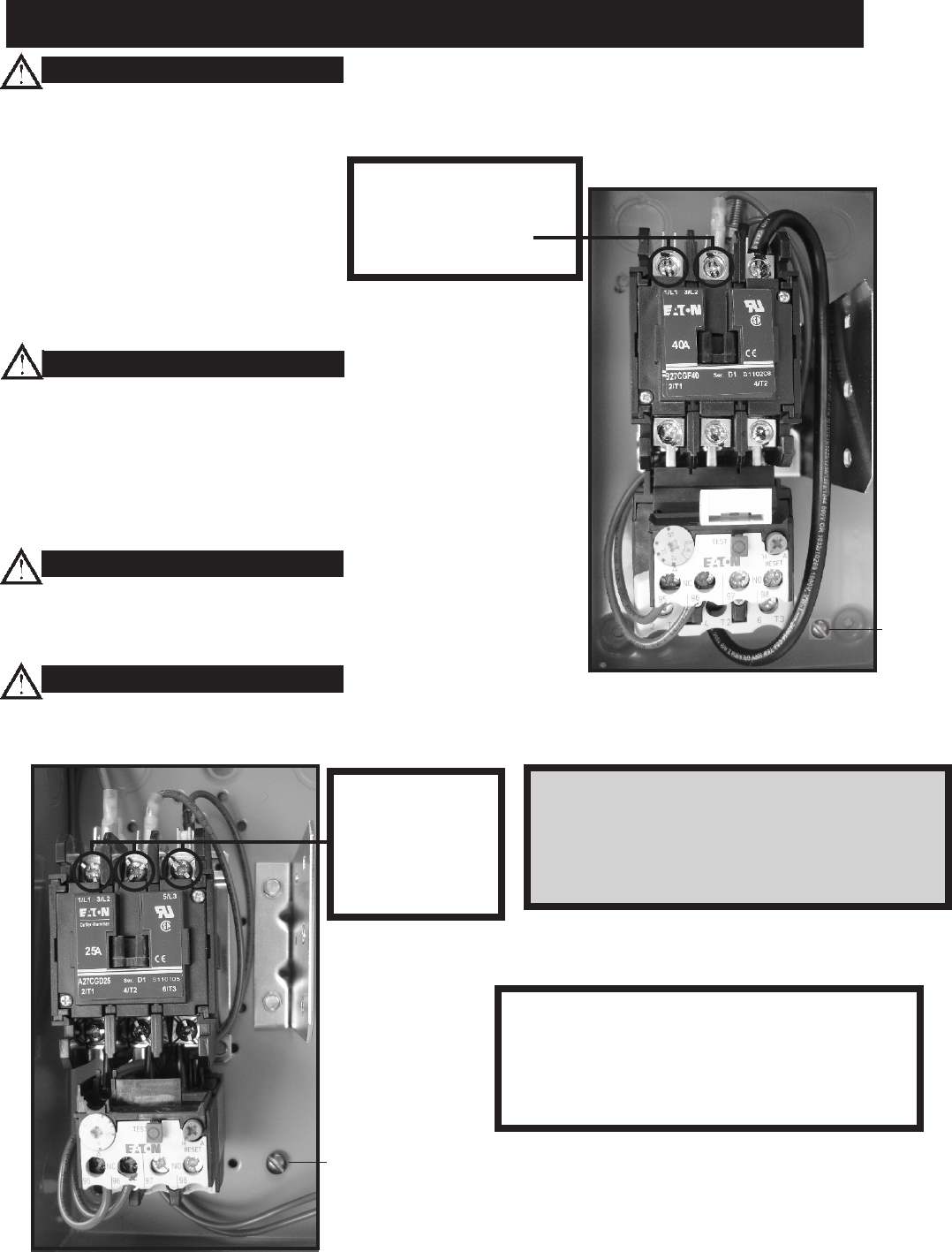
Page 6
To reduce the risk of electrical hazards, fire
hazards or damage to the compressor, use
proper circuit protection. Your compressor
is wired at the factory for operation using
the voltage shown. Connect the compressor
to a power source with the correct breaker
size.
Adequate wiring and motor protection
should be provided for all stationary
compressors. Wiring used for other
machinery should not be used. A
qualified electrician familiar with local
electrical codes in your area should be
used. Size supply wiring per NEC (National
Electric Code) requirements.
WIRING
ALL ELECTRICAL WIRING SHOULD BE DONE
BY A QUALIFIED ELECTRICIAN
General Information
Electrical connections must be properly
grounded. Ground connections should be
connected at the grounding screw.
Overheating, short circuiting and fire damage
will result from inadequate wiring.
WARNING
WARNING
WARNING
CAUTION
WIRING
Single Phase
Three Phase
Ground
Ground
Incoming power should
be connected to L1 and
L2 at the Top of the
Magnetic Starter.
Incoming power
should be
connected to
L1, L2 & L3 at
the Top of the
Magnetic Starter.
DO NOT MAKE CONNECTIONS
AT THE PRESSURE SWITCH
DUPLEX
Power should be brought into the
left hand starter. Do not bring power
to both starters.

Page 7
Note:Make sure to follow instructions carefully to avoid a short and possible damage
to the starter solenoid and/or battery.
1. Connect the positive (+) terminal on the battery to the starter solenoid.
2. Connect the negative (-) terminal on the battery to an engine mounting bolt or other
acceptable ground connection.
Always connect the positive(+) battery cable to the starter solenoid before connecting
the negative(-) battery cable.
NUMBER 2 WIRE OR LARGER IS REQUIRED
(Gas Drive Models)
Battery Connection Instructions for Electric Start Engines
PLEASE REFER TO YOUR ENGINE OPERATION MANUAL FOR PROPER STARTING
INSTRUCTIONS.
NAPA GASOLINE DRIVEN COMPRESSORS ARE EQUIPPED WITH A COLD START
VALVE FOR LOADLESS STARTS. THERE IS NO NEED TO MANUALLY UNLOAD
AIR PRESSURE.
BATTERY
(12 Volt)
(+)(-)
GROUND
Starter Solenoid
STARTING THE COMPRESSOR
Prior to running the compressor, check
the following items:
Crankcase oil - Make sure the sight glass
shows ½ full or slightly above.
Make sure all rags, tools, oil, etc. are away
from the unit.
Open the air system to free it of any pressure.
Switch the compressor on for a few
revolutions to make sure the rotation is
correct. Correct rotation is clockwise
when facing the sight glass on the pump.
Operate the compressor for a few minutes
unloaded (air system open) then allow the
compressor to pump up. Make sure the
electrical pressure switch properly switches
off the compressor according to the setting
desired. (175 PSI Max)
Make sure the pressure in the tank does
not exceed its rating. Maximum of 175 psi. If
the pressure gauge indicates a pressure that
is higher than these maximum pressures,
shut off compressor immediately and call
866-869-3114.
STARTING THE COMPRESSOR
CAUTION
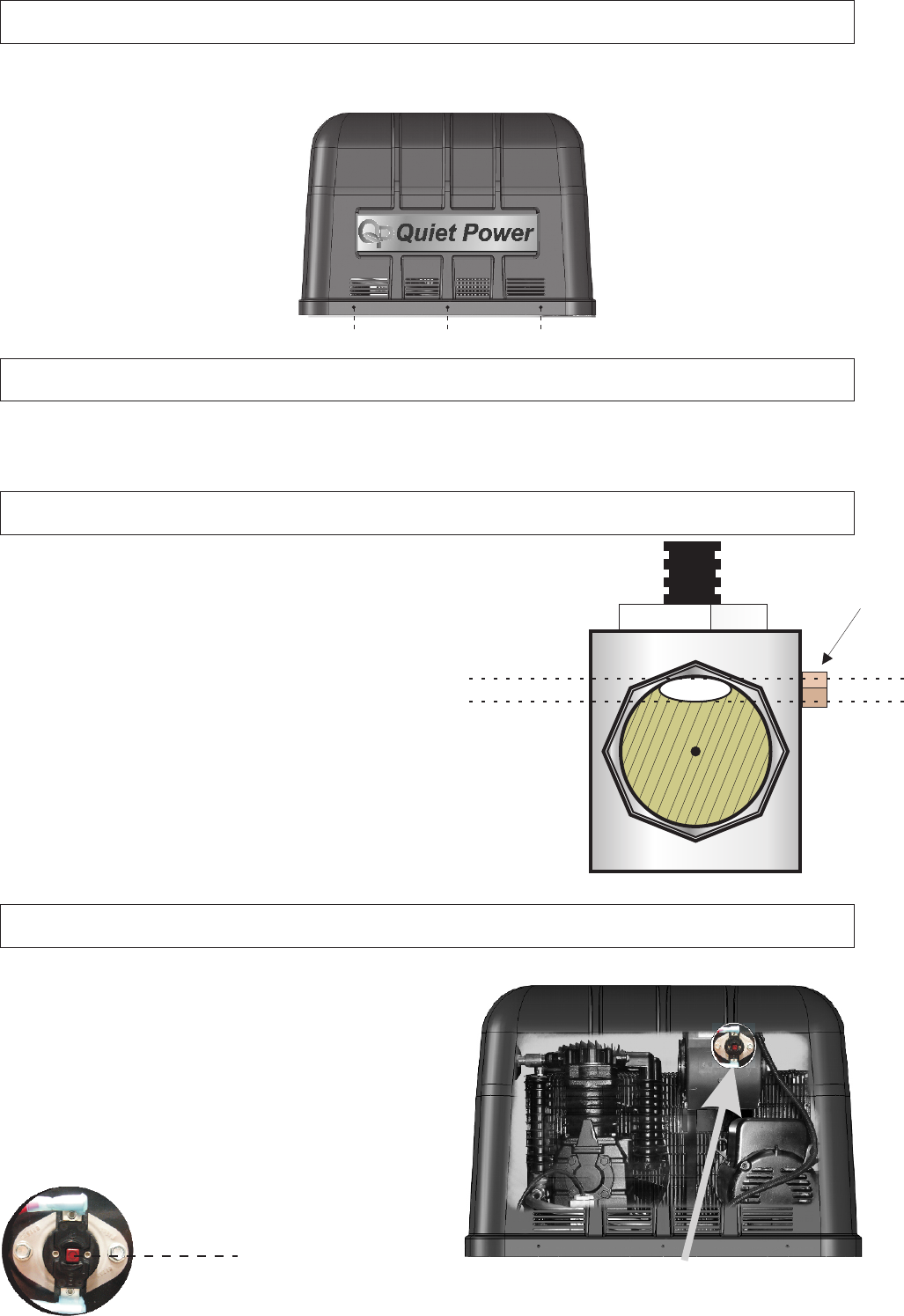
QP Compressors
QP and fully packaged models come equipped with low oil level switches and automatic tank
drains. The QP models also include protection against over-heating.
Page 8
Low Oil Level Switch
OIL
Target Oil Level
Oil Vent
Plug
The function of the low oil level switch
is to keep the air compressor from
starting if the oil level drops beyond
a certain point.
For compressors outfitted with the
low oil level switch, the oil should
in the top 1/3 of the oil sight glass.
When changing or adding oil, it is
important to remove the Oil Vent
Plug to allow for the oil to flow
completely into the switch.
(Please Note: If overfilled, oil will flow out
of the oil vent hole)
Thermal Protection - QP Models
If the cooling fan were to fail or
internal temperature were to reach
170°F the QP models are outfitted
with a thermal fuse.
When tripped, the fuse can be reset.
The canopy will need to be removed
to reset the thermal fuse.
Location of Fuse
(Inside Canopy
Behind Fan)
Press to
Reset
The QP comes equipped with sound attenuating enclosure. For maintenance, the canopy and
side foam pieces will need to be removed.
To remove the canopy, simply remove the 6 fasteners and lift the canopy straight up and off.
QP and Fully Packaged Compressors
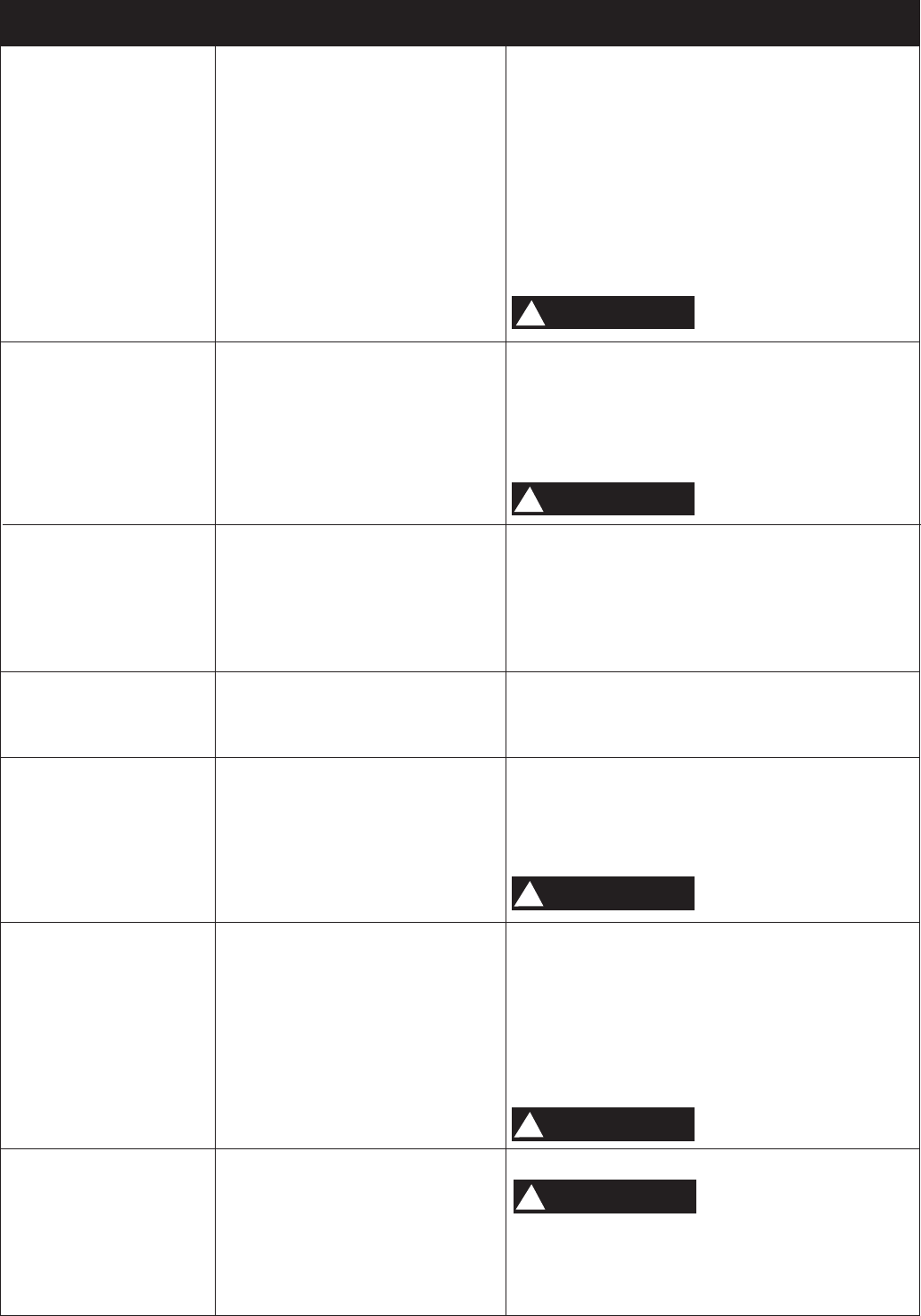
Page 9
!
DANGER
Low discharge pressure
1. Reduce air demand or use a compressor
with more air capacity.
2. Listen for air leaks. Apply a soap solution
to all fittings and connections. Bubbles
will form at points of leakage. Tighten
or replace fittings or connections.
3. Clean or replace air filter.
4. Replace necessary gaskets.
5. Remove head and inspect for broken or
misaligned valves. Replace valves, if
necessary.
Install a new head gasket
each time head is removed
1. Tighten drive pulley or flywheel bolt.
2. Check for proper oil level. Low or dirty
oil may cause bearing damage.
3. Replace connecting rod and/or connecting
rod bearings.
4. Replace check valve.
with air pressure in tank
1. Replace with new piston rings.
2. Clean or replace air filter.
3. Drain oil to proper oil level.
4. Use a quality non-detergent 30 or 40wt
oil specified for each model (Page 4).
1. Drain tank at least once per day.
2. Add an inline filter to reduce moisture in
in the air line.
1. Check voltage with volt meter across both
legs of incoming power. Check reset button
on motor.
2. Repair or replace pressure switch.
3. Replace check valve or pressure switch.
Do not remove check valve
with air pressure in tank
1. Make sure the breaker is sized properly.
See page 6 in this manual.
2. Check voltage with volt meter across both
legs of incoming power.
3. Replace motor.
4. Check all electrical connections.
5. Adjust or replace pressure switch.
6. Replace check valve.
Do not remove check valve
with air pressure in tank
1. Replace check valve.
Do not remove check valve
with air pressure in tank
2. Tighten or replace fittings or connections.
3. Replace tank. Do not attempt to repair tank.
Do not remove check valve
1. Compressor too small for
application
2. Air leaks
3. Restricted intake air
4. Blown gasket(s)
5. Broken or misaligned valves
!
DANGER
!
DANGER
!
DANGER
1. Loose drive pulley or flywheel
2. Low on oil
3. Worn connecting rod or
connecting rod bearing
4. Noisy check valve
1. Worn piston rings
2. Restricted intake air
3. Too much oil in compressor
4. Incorrect oil viscosity
1. Normal. Amount of water will
increase as humidity in the
air increases.
1. Low voltage
2. Malfunctioning pressure switch
3. Malfunctioning check valve
1. Incorrect breaker size
2. Low voltage
3. Malfunctioning motor
4. Loose electrical connections
5. Malfunctioning pressure switch
6. Malfunctioning check valve
Tank does not hold
pressure when not
running and shut off
valve is closed
Breaker or reset
repeatedly trips
Will not run or motor
hums
Water in tank and/or
discharge line
Excessive oil carryover
Excessive noise
“knocking”
TROUBLESHOOTING GUIDE
1. Malfunctioning check valve
2. Loose fittings or connections
3. Crack or pin hole in tank
CAUTION
!
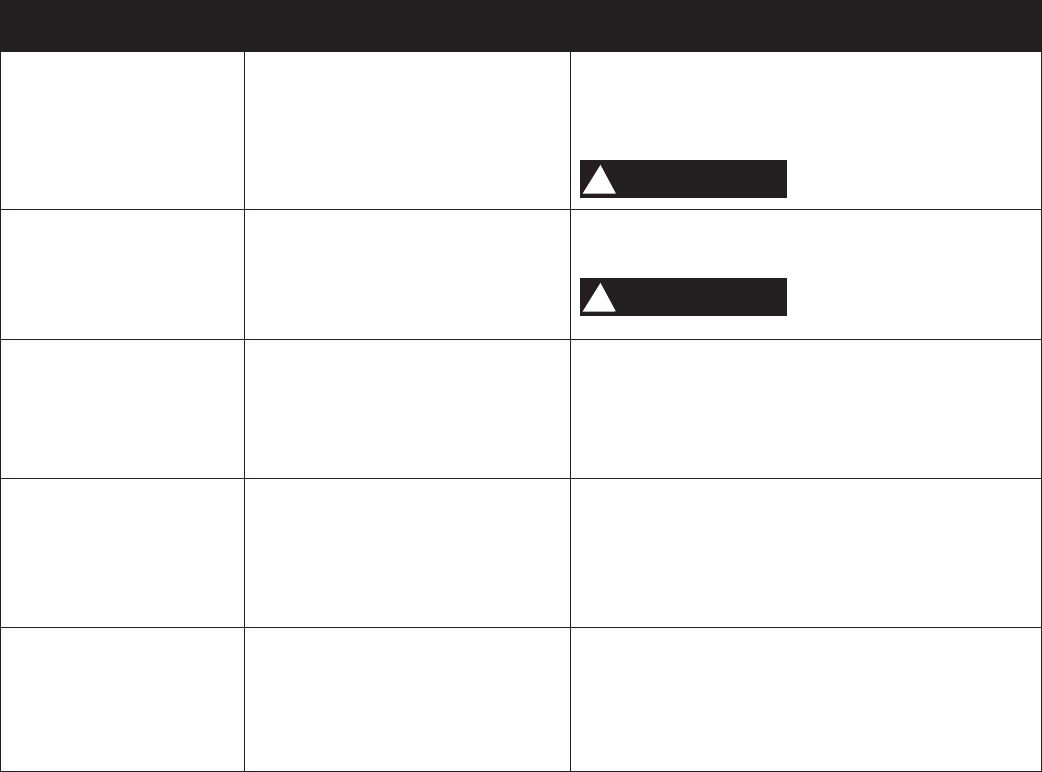
Page 10
1. Replace pressure switch if it does not release
air pressure briefly when unit shuts off.
Do not remove pressure
switch with air pressure in
tank
1. Make sure unit is mounted on a level surface
with vibration pads.
2. Replace belts. Align and tighten properly.
3. Align flywheel and drive pulley.
1. Reduce air demand or use a compressor
with more air capacity.
2. Clean all cooling surfaces of dirt and dust.
3. Install compressor in an area with adequate
cool dry air.
1. Malfunctioning check valve
Overheating
TROUBLESHOOTING GUIDE (Continued)
Pressure switch un-
loader constantly
leaking air
1. Replace check valve if unloader bleeds
constantly.
Do not remove check valve
with air pressure in tank
!
DANGER
Pressure switch not
unloading
1. Malfunctioning pressure
switch
!
DANGER
Excessive vibration
1. Compressor too small for
application
2. Cooling surfaces dirty
3. Improper cooling
1. Improper installation
2. Loose belts
3. Misaligned flywheel or
drive pulley
Will Not Start
(Elite and QP)
1. Unit Low on Oil
2. Exhaust Fan Not Working
1. Add Oil to Proper Level
2. Reset Thermal Overload
The Company warrants that the Equipment manufactured by it and delivered hereunder shall be free from defects in material and
workmanship for a period of twelve (12) months from the date of initial start-up, or eighteen (18) months from the date of shipment
from the manufacturer, whichever occurs first. The foregoing warranty period shall apply to all Equipment, except for the following: (A) all
two stage reciprocating stationary models are warranted for the earlier of twenty-four (24) months from the date of initial operation or thirty
(30) months from date of shipment from the manufacturer. (B) Replacement parts will be warranted for three (3) months from the date of
shipment from the manufacturer. Should the failure to conform to this warranty be reported in writing to the Company within said
period, the Company shall, at its option, correct such non - conformity by suitable repair to such Equipment, or furnish a
replacement part F.O.B point of shipment, provided that the Purchaser has installed, maintained, and operated such Equipment in
accordance with good industry practices, and has complied with specific recommendations of the Company. Accessories and
equipment furnished by the Company, but manufactured by others, shall carry whatever warranty the manufacturer conveyed to the
Company and which can be passed on to the Purchaser. The Company shall not be liable for any repairs, replacements, or adjustments
to the Equipment, or any costs of labor performed by the Purchaser without the Company’s prior written approval.
The Company makes no performance warranty unless specifically stated within its proposal, and the effects of corrosion, erosion, and
normal wear and tear are specifically excluded from the Company’s warranty. In the event performance warranties are expressly
included, the Company’s obligation shall be to correct in the manner and for the period of time provided above
This warranty does not apply to electric motors or gasoline engines. These are covered by the Original Manufacturer’s Warranty and
should be returned (by the customer) to their authorized service center for service..
THE COMPANY MAKES NO OTHER WARRANTY OR REPRESENTATION OF ANY KIND WHATSOEVER,
EXPRESSED OR IMPLIED, EXCEPT THAT OF TITLE, AND ALL IMPLIED WARRANTIES OF MERCHANTABILITY
AND FITNESS FOR A PARTICULAR PURPOSE, ARE HEREBY DISCLAIMED. THIS WARRANTY SUPERSEDES ALL
PREVIOUS WARRANTY STATEMENTS.
Correction by the Company of non-conformities, whether patent or latent, in the manner and for the period of time provided above, shall
constitute fulfillment of all liabilities of the Company and its distributors for such non-conformities with respect to, or arising out of such
Equipment.
LIMITATION OF LIABILITY
THE REMEDIES OF THE PURCHASER SET FORTH HEREIN ARE EXCLUSIVE, AND THE TOTAL LIABILITY OF THE COMPANY,
ITS DISTRIBUTORS AND SUPPLIERS WITH RESPECT TO CONTRACT OR THE EQUIPMENT AND SERVICES FURNISHED IN
CONNECTION WITH THE PERFORMANCE OR BREACH THEREOF, OR FROM THE MANUFACTURE, SALE, DELIVERY,
INSTALLATION, REPAIR OR TECHNICAL DIRECTION COVERED OR FURNISHED UNDER CONTRACT, WHETHER BASED
ON CONTRACT, WARRANTY, NEGLIGENCE, INDEMNITY, STRICT LIABILITY OR OTHERWISE, SHALL NOT EXCEED THE
PURCHASE PRICE OF THE EQUIPMENT UPON WHICH SUCH LIABILITY IS BASED.
THE COMPANY, ITS DISTRIBUTORS AND ITS SUPPLIERS SHALL IN NO EVENT BE LIABLE TO THE PURCHASER, ANY
SUCCESSORS IN INTEREST, OR ANY BENEFICIARY OR ASSIGNEE OF THE CONTRACT FOR ANY
CONSEQUENTIAL, INCIDENTAL, INDIRECT, SPECIAL OR PUNITIVE DAMAGES ARISING OUT OF THIS CONTRACT OR ANY
BREACH THEREOF, OR ANY DEFECT IN, OR FAILURE OF, OR MALFUNCTION OF THE EQUIPMENT, WHETHER OR NOT
BASED ON LOSS OF USE, LOST PROFITS OR REVENUE, INTEREST, LOST GOODWILL, WORK STOPPAGE, IMPAIRMENT
OF OTHER GOODS, LOSS BY REASON OF SHUTDOWN OR NON-OPERATION, COST OF PURCHASE OF REPLACEMENT
POWER, OR CLAIMS OF PURCHASER OR CUSTOMERS OF PURCHASER FOR SERVICE INTERRUPTION, WHETHER OR NOT
SUCH LOSS OR DAMAGE IS BASED ON CONTRACT, WARRANTY, NEGLIGENCE, INDEMNITY, STRICT LIABILITY OR OTHERWISE.
Warranty Statement
Atlas Copco Compressors
1800 Overview Drive
Rock Hill, SC 29730
866-869-3114
